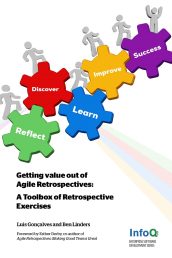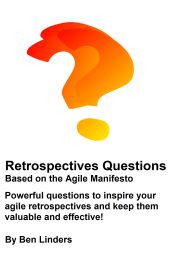 Design your own Valuable Agile Retrospectives with the Retrospective Exercises Toolbox!
Design your own Valuable Agile Retrospectives with the Retrospective Exercises Toolbox!
Having a “toolbox” to do agile retrospectives helps you as a retrospective facilitator to deliver more value to a team. Teams are different, and also the things that teams are dealing with can differ from sprint to sprint. Therefore it helps if you know many retrospective exercises that you can choose from. You can plan a retrospective meeting, and think about the technique that you want to use, but be open to change it on the spot whenever needed.
Why use different retrospective techniques?
The purpose of selecting a retrospective technique is to get more business value out of agile retrospectives, and use a technique that finds the most important things that teams can work on to improve their process (BTW: my definition of a process is “the way we work around here”).
What is most important? It can be their biggest impediment that they have right now (where I would recommend to do a Root Cause Analysis to understand it and define effective actions), or something that is bothering the team but that they can’t get a hold on, or the reason that the current sprint failed, or was a big success (where you could investigated how to use the strengths which the professionals already have to improve further).
Retrospectives are used to improve continuously, thus helping teams and organization to become more agile and lean.
A day with 2 retrospectives
I remember a day where I had 2 retro’s with teams that I hadn’t worked with before. The first team was a group of youngsters, who learned agile very quickly. They hated processes, and wanted to have a little format as possible; they do things their way. Every retrospective that they had before was an unstructured discussion, but they always found some things to improve upon.
When I started the retrospective, I checked how they wanted to do it, expecting that it would be a discussion with some questions firing it off. To my surprise, they asked me to do a sessions with sticky notes and questions, as they had heard from another team that they had gotten good results with it. I always carry my retrospective bag with me, so I got some pencils and sticky notes out, and wrote the retrospective questions on a flip-over (see Which Questions do you Ask in Retrospectives if you want to learn about questions that you can use). In silence they noted their answers, clustered them, and found some new improvement points that they could work on as a team.
The second team that I did a retrospective with that day always did sticky notes. When I came into the room, I felt immediately that there was a serious problem that was bothering the team. Somehow you see or “smell” it, can’t really explain how, but as an experienced facilitator you can observe a lot by just watching. So I asked them to do a quick round before we would do the standard questions, where they would use 1 word to describe how they felt about the sprint. The first two team members used a somewhat neutral word, but the third one said that “the sprint really sucked”.
I asked him why, and after he explained it shortly, I finished the round with the remaining team members, who also made clear that they weren’t happy how things had gone, and also the first two team members confirmed that there had been severe problems. I facilitated a discussion, which revealed the major problems that they had, and we got some great learnings.
When we were almost at the end of the session, one of team members said: “shouldn’t we use sticky notes, as we always do in retrospectives?”. His colleagues interrupted him, and explained that they found the discussion useful, so we continued and wrapped it up by writing the main conclusions and actions on a flip-over. They learned a lot that day!
Develop your toolbox of retrospective techniques
2 retrospectives on 1 day, where I used different techniques than the ones that I expected to use. My advice to a retrospective facilitator: Learn as many different retrospective techniques as you can, you may need them one day. And always take your retrospective exercises toolbox with you, and use it wisely, so that you can bring value to your teams in retrospectives 🙂
 The book Getting Value out of Agile Retrospectives – A Toolbox of Retrospective Exercises written by Luis Gonçalves and Ben Linders contains many exercises that you can use to facilitate retrospectives, supported with the “why”, “what” and “how” of retrospectives, the business value and benefits that they can bring you, and advice for introducing and improving retrospectives.
The book Getting Value out of Agile Retrospectives – A Toolbox of Retrospective Exercises written by Luis Gonçalves and Ben Linders contains many exercises that you can use to facilitate retrospectives, supported with the “why”, “what” and “how” of retrospectives, the business value and benefits that they can bring you, and advice for introducing and improving retrospectives.
 The Leanpub bundle Agile Retrospectives offers six great books to do amazing Agile Retrospectives. Together these books will make your Agile retrospectives rock! Teams will love to do them. And now you can get these books with a significant discount :-).
The Leanpub bundle Agile Retrospectives offers six great books to do amazing Agile Retrospectives. Together these books will make your Agile retrospectives rock! Teams will love to do them. And now you can get these books with a significant discount :-).
Retrospective Facilitator Tools
The following books and tools are available to do valuable agile retrospectives:
-
- Digital Downloads, Packages
Agile Self-assessment Game & Expansion Packs
- €1.99 – €9.99 (Excl. VAT)
- View products
-
- Workshops
Workshop Valuable Agile Retrospectives for Teams
- €350.00 – €450.00 (Excl. VAT)
- Select options










Hi Ben!
Very nice story on how being able to react to the mood 🙂
As for learning techniques, maybe the Retr-O-Mat is helpful for your readers: http://www.plans-for-retrospectives.com/
Cheers, Corinna
Hi Corinna,
It certainly is, highly recommended this one to my readers!
Thanks for sharing it 🙂
Regards,
Ben Linders
Great thoughts, I liked the toolbox idea. I come here often. Thank you Ben.
Thanks for your kind words Saeavana!
Next to our book there’s no a toolbox page where you can select exercises for designing your next retrospectives:
Retrospective Exercises
What do you think of this?